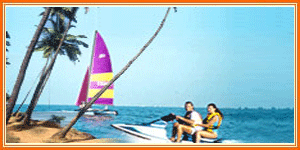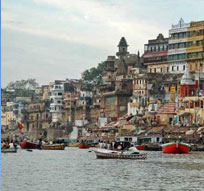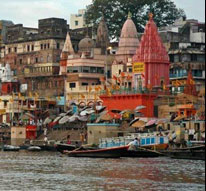The ancient Hindu land of Goa, of which hardly a fragment survives, was built at the southernmost point of the island. Known as Gove,

Govapuri, and Gomant in the Puranas and certain inscriptions, Goa was famous in early Hindu legend and history. The medieval Arabian geographers knew it as Sindabur or Sandabur, and the Portuguese as Velha Goa. Goa's history stretches back to the 3rd century BC, when it was part of the Mauryan empire. Later, at the beginning of the Christian era, it was ruled by the Satavahanas of Kolhapur. Control eventually passed to the Chalukyans of Badami, who ruled from 580 to 750 AD. Goa fell to the Muslims for the first time in 1312, but the invaders were forced out in 1370 by Harihara I of the Vijayanagar empire, whose capital was at Hampi. Over the next 100 years, Goa's harbours were important landing places for ships carrying Arabian horses to the Vijayanagar cavalry at Hampi.
In 1510 the charm and the geographical location of Goa attracted the Portuguese to the land. Their aim was to control the spice route from the east and also carried a mission to spread Christianity. St Francis Xavier with his Jesuit missionaries, arrived in 1542. Portuguese control had expanded beyond Old Goa to include the provinces of Bardez and Salcete, by the middle of the 16th century.
Apart from the Portuguese, the parts of Goa had captivated many from the
west - the Turks, the British, the French, the Dutch. The most
prosperous times of Goa happened with the eventual ousting of the
Turks, who controlled the trade routes across the Indian Ocean, and
the resultant fortunes made from the spice trade. The colony became
the viceregal seat of the Portuguese empire of the east, including
various East African port cities, East Timor and Macau. But rivalry
between the British, French and Dutch in the 17th century, combined
with Portugal's lack of ability to service its distant empire, led
to their decline. The Portuguese were nearly overthrown by the
Marathas in the late 18th century. However, the Portuguese clung on
till 1961, when they were finally ejected by India. Goa remained a
Union territory for 26 years and gained full fledged statehood on
August 12th 1987.
Beaches in Goa
- Arambol Beach
Around 40 km north of Panaji and 18
km north of Chapora. Till recently Arambol was a favorite Goa
beach for those maverick tourists for whom a Goa holiday meant
non-confirming to any code-of-conduct, and who found even Anjuna
too constraining. Paradoxically, but logically it slowly became
popular, losing its isolation and attracting some development
activities and the traffic of day-trippers.
- Colva Beach
The Colva Beach is broad and
beautiful, and has a stream coursing through it. Colva is the
oldest and largest of South Goa's resorts. Its leafy outlying
'Vaddos', or wards are pleasant enough, dotted with colonial
style villas and ramshackle fishing huts. The beach front is a
collection of concrete hotels, souvenir stalls and fly blown
snack bars strewn around a central roundabout.
- Benaulim Beach
Less than 2 km south of Colva is
the even more peaceful and serene beach of Benaulim, well known
as the location for Taj Exotica, Goa. The swimming is good and
long beach walks, a staple of a Goa holiday are specially
enjoyable north to Colva. Walks or rides on the Beach Road
through picturesque countryside 4 km to Colva are also equally
enjoyable. The otherwise tranquil beach tends to get crowded on
weekends when it attracts local picnickers.
- Palolem Beach
Palolem beach, Goa was discovered
by those lost souls searching for an idyllic beach of Goa,
unspoiled from the vagaries of the typical whoop-de-do
activities of Goa tourism found in the more popular beaches of
Goa. What they found was beach utopia; sensual curves of
crescent shaped palm fringed golden sands, gently caressed by
the waves between two unusual rocky headlands.
- Bogmalo Beach
Derived from Sanskrit word "Banali"
and later corrupted by the Portuguese to Benaulim, the beautiful
beach lies in the center of Colva Beach, 7-km west of Margao.
Only a decade ago, this fishing and rice-farming village,
scattered around the coconut groves and paddy fields had barely
made it onto the backpackers map. This beach remains a peaceful
and welcoming place to unwind.
- Anjuna Beach
The beauty of the white waves
rushing to embrace the golden sand on the beach can be witnessed
in full form at the Goa Anjuna beach. Goa Anjuna beach comes to
life with the flea market and the full-moon beach parties that
continue through out the night. 18 km north of Panaji, Anjuna
beach is the most popular hotspots of Goa and India tourism.
- Vagator Beach
22 km north of Panaji. Part of the
30 km coastline stretch of Northern Beaches of Goa that covers
the most popular hotspots of Goa and India tourism. Just to the
north of the party beach of Goa is a fascinating group of small
Goa beaches, more salubrious and laid-back than Anjuna.
Relatively secluded, these are situated on the crescent shaped
Caisua bay, along the Chapora river basin, in the shadow of the
ruins of Chapora Fort.
How to Reach
- By Air
Goa's international airport is Dabolim, at
a distance of 29 km from Panaji, on the coast near Vasco Da
Gama. Most domestic airlines operate in Goa apart from chartered
private airlines operating from UK and Germany. Indian Airlines
has direct flights from Delhi and Mumbai daily. Air India also
flies to Goa.
- By Rail
Reaching Goa by train is easy from Mumbai
(490 km), Bangalore (430 km), and Delhi (1,874 km). Goa's two
main stations are at Margao and Vasco Da Gama.
- By Road
We can provide you the tourist car or
coach for the road transpotation, even from the neighbouring
states of Maharashtra, Karnataka and also for the in city drives
and sightseeing trips.









